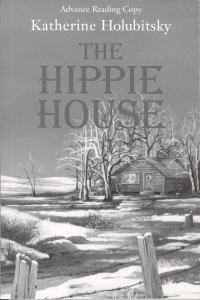| ________________
CM . . .
. Volume X Number 20 . . . . June 4, 2004
excerpt:
Told in the voice of 14-year-old Emma, The Hippie House is the story of one year in the life of the community of Pike Creek, Ontario, after Emma’s brother, Eric, finds the body of a local girl (Katie Russell) in the Hippie House. The Hippie House is a shed of sorts that Emma’s dad has constructed on their hobby farm to get away from her mother’s “blessed cigarettes,” but it has been adopted by Eric to house his garage band, “The Rectifiers.” Katie Russell’s murder is followed shortly by the death of another young woman, Fiona Young, and the community is paralyzed by fear and suspicion. There is, of course, much finger pointing and speculation about what happened to these young women. Holubitsky is a solid writer who builds well constructed books, and The Hippie House is no exception. There is nothing really wrong with this book, but there is also nothing really right, either. It simply does not stand out. The young narrator, Emma, is not a particularly compelling storyteller, and the reader is often distracted from the story by all the references to Emma’s interest in sewing – what she is currently sewing, pieces of fabric, her involvement creating costumes for the school plays, buying trim for an outfit she is making for herself, etc. Interestingly, a secondary character, Megan, who is Emma’s older cousin and constant companion, could probably have carried off the narration better because of her personality and attitude. The Hippie House takes place in 1971, and Holubitsky has endeavored to include a multitude of current references to make the story feel authentic to that particular time in Canadian society. However, it seems unlikely that today’s middle schooler will have much interest in (or be able to relate to) Pierre LaPorte’s death, Charles Manson, Cybill Shepherd, or Coco Chanel. They may be able to identify some of the music referred to as vintage rock and roll! Katherine Holubitsky uses a lot of words to solve this mystery; an event that occurs very near the end of the book, and the actual revelation of “whodunit” is almost a denouement in that there is no real crescendo or surprise. It is almost a let down to the reader. As well, this a very female-centric telling and will have limited interest for young males, despite the subplot of the garage band and a young male who is diagnosed with schizophrenia. Recommended. Anne Letain is a teacher-librarian and school library consultant in Southern Alberta.
To comment
on this title or this review, send mail to cm@umanitoba.ca.
Copyright © the Manitoba Library Association. Reproduction for personal
use is permitted only if this copyright notice is maintained. Any
other reproduction is prohibited without permission.
NEXT REVIEW |
TABLE OF CONTENTS FOR THIS ISSUE
- June 4, 2004.
AUTHORS |
TITLES |
MEDIA REVIEWS |
PROFILES |
BACK ISSUES |
SEARCH |
CMARCHIVE |
HOME |
